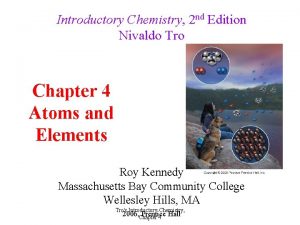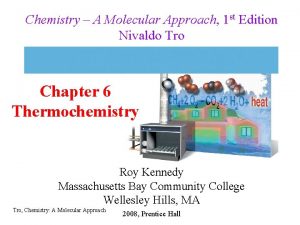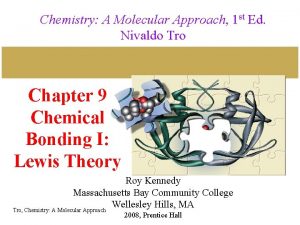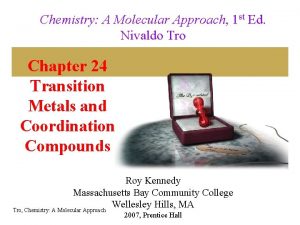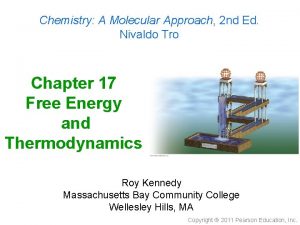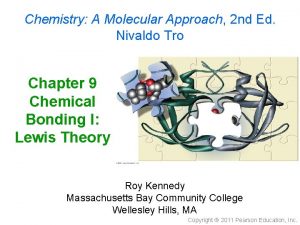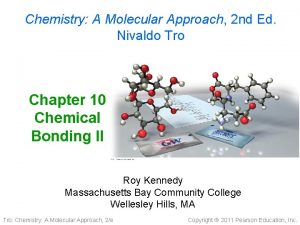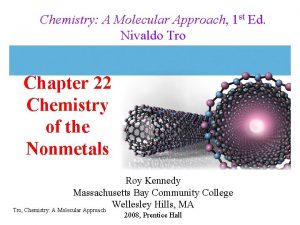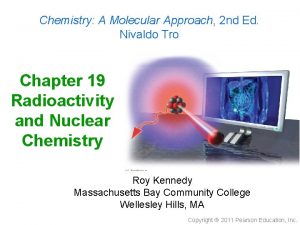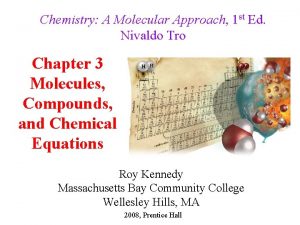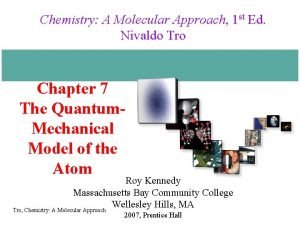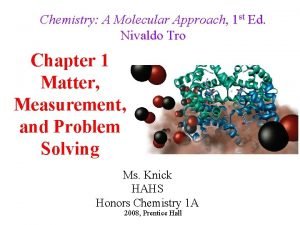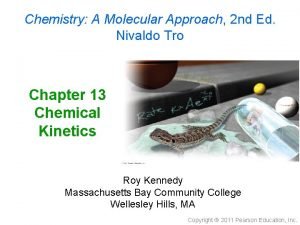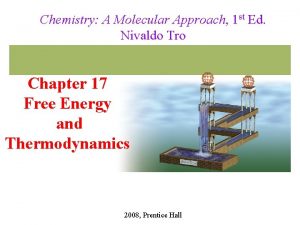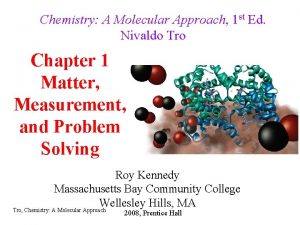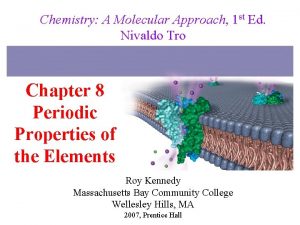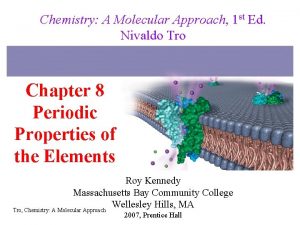Chemistry A Molecular Approach 1 st Edition Nivaldo





















- Slides: 21

Chemistry – A Molecular Approach, 1 st Edition Nivaldo Tro Chapter 6 Thermochemistry 2008, Prentice Hall

Heating Your Home • most homes burn fossil fuels to generate heat • the amount the temperature of your home increases depends on several factors ühow much fuel is burned üthe volume of the house üthe amount of heat loss üthe efficiency of the burning process ücan you think of any others? Tro, Chemistry: A Molecular Approach 2

Nature of Energy • even though Chemistry is the study of • • matter, energy effects matter energy is anything that has the capacity to do work is a force acting over a distance üEnergy = Work = Force x Distance • energy can be exchanged between objects through contact ücollisions Tro, Chemistry: A Molecular Approach 3

Classification of Energy • Kinetic energy is energy of motion or energy that is being transferred üthermal energy is kinetic Tro, Chemistry: A Molecular Approach 4

Classification of Energy • Potential energy is energy that is stored in an object, or energy associated with the composition and position of the object üenergy stored in the structure of a compound is potential Tro, Chemistry: A Molecular Approach 5

Law of Conservation of Energy • energy cannot be created or destroyed ü First Law of Thermodynamics • energy can be transferred • between objects energy can be transformed from one form to another ü heat → light → sound Tro, Chemistry: A Molecular Approach 6

Some Forms of Energy • Electrical ü kinetic energy associated with the flow of electrical charge • Heat or Thermal Energy ü kinetic energy associated with molecular motion • Light or Radiant Energy ü kinetic energy associated with energy transitions in an atom • Nuclear ü potential energy in the nucleus of atoms • Chemical ü potential energy in the attachment of atoms or because of their position Tro, Chemistry: A Molecular Approach 7

Units of Energy • joule (J) is the amount of energy needed to move • a 1 kg mass a distance of 1 meter calorie (cal) is the amount of energy needed to raise one gram of water by 1°C ükcal = energy needed to raise 1000 g of water 1°C üfood Calories = kcals Energy Conversion Factors 1 calorie (cal) 1 Calorie (Cal) Tro, Chemistry: A Molecular Approach = = 4. 184 joules (J) (exact) 1000 calories (cal) 8

Energy Flow and Conservation of Energy • we define the system as the material or process we are • • studying the energy changes within we define the surroundings as everything else in the universe Conservation of Energy requires that the total energy change in the system and the surrounding must be zero ü DEnergyuniverse = 0 = DEnergysystem + DEnergysurroundings ü D is the symbol that is used to mean change Ø final amount – initial amount 9

Energy Flow • when energy flows out of a • • • system, it must all flow into the surroundings when energy flows out of a system, DEsystem is ─ when energy flows into the surroundings, DEsurroundings is + therefore: ─ DEsystem= DEsurroundings Tro, Chemistry: A Molecular Approach Surroundings DE + System DE ─ 10

Energy Flow • when energy flows into a • • • system, it must all come from the surroundings when energy flows into a system, DEsystem is + when energy flows out of the surroundings, DEsurroundings is ─ therefore: DEsystem= ─ DEsurroundings Tro, Chemistry: A Molecular Approach Surroundings DE ─ System DE + 11

Quantity of Heat Energy Absorbed Heat Capacity • when a system absorbs heat, its temperature increases • the increase in temperature is directly proportional to the • amount of heat absorbed the proportionality constant is called the heat capacity, C ü units of C are J/°C or J/K • q = C x DT the heat capacity of an object depends on its mass ü 200 g of water requires twice as much heat to raise its temperature by 1°C than 100 g of water • the heat capacity of an object depends on the type of material ü 1000 J of heat energy will raise the temperature of 100 g of sand 12°C, but only raise the temperature of 100 g of water by 2. 4°C Tro, Chemistry: A Molecular Approach 12

Specific Heat Capacity • measure of a substance’s intrinsic ability to • absorb heat the specific heat capacity is the amount of heat energy required to raise the temperature of one gram of a substance 1°C ü Cs ü units are J/(g∙°C) Tro, Chemistry: A Molecular Approach 13

Quantifying Heat Energy • the heat capacity of an object is proportional to its mass • and the specific heat of the material so we can calculate the quantity of heat absorbed by an object if we know the mass, the specific heat, and the temperature change of the object Heat = (mass) x (specific heat capacity) x (temp. change) q = (m) x (Cs) x (DT) Tro, Chemistry: A Molecular Approach 14

Example 6. 2 – How much heat is absorbed by a copper penny with mass 3. 10 g whose temperature rises from -8. 0°C to 37. 0°C? Tro, Chemistry: A Molecular Approach 15

Enthalpy • the enthalpy change, DH, of a reaction is the heat evolved in a reaction at constant pressure Tro, Chemistry: A Molecular Approach 16

Endothermic and Exothermic Reactions • • • when DH is ─, heat is being released by the system reactions that release heat are called exothermic reactions when DH is +, heat is being absorbed by the system reactions that release heat are called endothermic reactions chemical heat packs contain iron filings that are oxidized in an exothermic reaction ─ your hands get warm because the released heat of the reaction is absorbed by your hands chemical cold packs contain NH 4 NO 3 that dissolves in water in an endothermic process ─ your hands get cold because they are giving away your heat to the reaction 17

Molecular View of Exothermic Reactions • in an exothermic reaction, the • • temperature rises due to release of thermal energy this extra thermal energy comes from the conversion of some of the chemical potential energy in the reactants into kinetic energy in the form of heat during the course of a reaction, old bonds are broken and new bonds made the products of the reaction have less chemical potential energy than the reactants the difference in energy is released as heat 18

Molecular View of Endothermic Reactions • in an endothermic reaction, the temperature drops due • • to absorption of thermal energy the required thermal energy comes from the surroundings during the course of a reaction, old bonds are broken and new bonds made the products of the reaction have more chemical potential energy than the reactants to acquire this extra energy, some of thermal energy of the surroundings is converted into chemical potential energy stored in the products Tro, Chemistry: A Molecular Approach 19

Relationships Involving DHrxn Hess’s Law • if a reaction can be expressed as a series of steps, then the DHrxn for the overall reaction is the sum of the heats of reaction for each step Tro, Chemistry: A Molecular Approach 20

Sample – Hess’s Law Given the following information: 2 NO(g) + O 2(g) 2 NO 2(g) 2 N 2(g) + 5 O 2(g) + 2 H 2 O(l) 4 HNO 3(aq) N 2(g) + O 2(g) 2 NO(g) DH° = -173 k. J DH° = -255 k. J DH° = +181 k. J Calculate the DH° for the reaction below: 3 NO 2(g) + H 2 O(l) 2 HNO 3(aq) + NO(g) DH° = ? [32 NO 2(g) 32 NO(g) + 1. 5 O 2(g)] x 1. 5 DH° = (+259. 5 1. 5(+173 k. J) [1 HNO k. J) [2 N 2(g) + 2. 5 5 OO + +2 1 HH 4 2 HNO x 0. 5 DH° = (-128 0. 5(-255 2(g) 2 O(l) 3(aq)] [2 NO(g) N 2(g) + O 2(g)] DH° = -181 k. J 3 NO 2(g) + H 2 O(l) 2 HNO 3(aq) + NO(g) DH° = - 49 k. J Tro, Chemistry: A Molecular Approach 21
 Prefix multipliers
Prefix multipliers Introductory chemistry 5th edition answers
Introductory chemistry 5th edition answers Democritus atomic model diagram
Democritus atomic model diagram Nivaldo j. tro introductory chemistry
Nivaldo j. tro introductory chemistry Covalently bonded substances
Covalently bonded substances Ionic covalent metallic
Ionic covalent metallic Zinc oxide + nitric acid → zinc nitrate + water
Zinc oxide + nitric acid → zinc nitrate + water Molecular biology of the cell seventh edition
Molecular biology of the cell seventh edition Molecular biology of the cell fifth edition
Molecular biology of the cell fifth edition Molecular biology
Molecular biology Using mis 10th edition
Using mis 10th edition Mis
Mis Ap chemistry molecular geometry
Ap chemistry molecular geometry Transition state energy diagram
Transition state energy diagram Pericyclic
Pericyclic Klein organic chemistry 2nd edition
Klein organic chemistry 2nd edition Introductory chemistry 4th edition
Introductory chemistry 4th edition Chemistry the central science 14th edition
Chemistry the central science 14th edition Reaction of grignard reagent with acid chloride
Reaction of grignard reagent with acid chloride David klein organic chemistry 3rd edition
David klein organic chemistry 3rd edition Ap chemistry notes zumdahl
Ap chemistry notes zumdahl Organic chemistry third edition david klein
Organic chemistry third edition david klein



